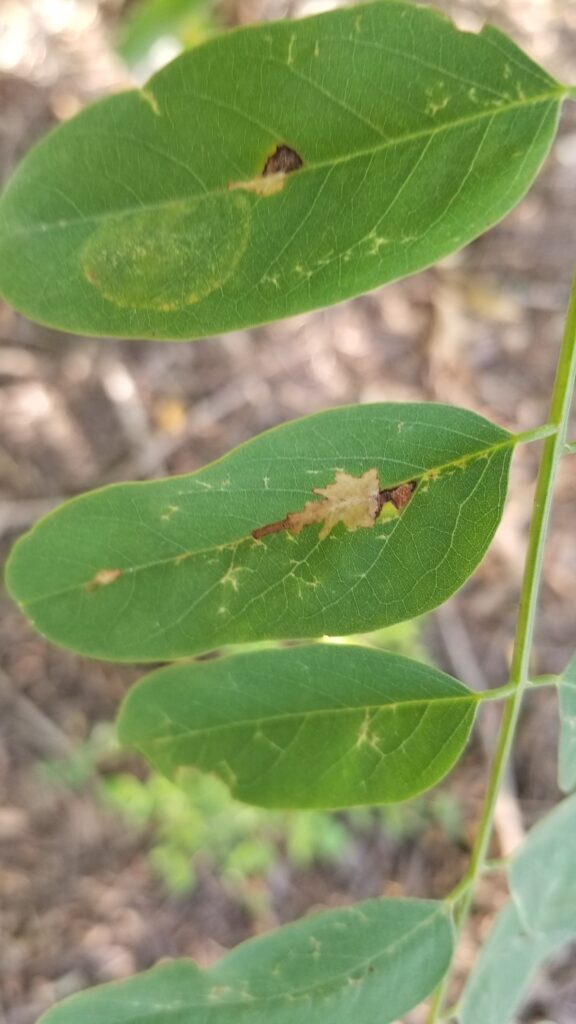Taxonomy
Family: Fabaceae
Genus: Robinia
Species: Robinia pseudoacacia L
Common name: Black locust
Morphology
Type: hardwood deciduous tree
Size: up to 15 m, or, in unusual cases, it can reach up to 24 m (Robinia pseudoacacia, n.d.)
Leaves: ovate-oblong dark blue-green leaflets forming pinnately compound alternate leaves, ranging from 15 to 36 cm with short prickles in the axil of the leaflet (TWC Staff, 2022; Robinia pseudoacacia, 2023).
Flowers: large, intensely fragrant clusters. It blooms in white and yellow racemes (resembling peas) from April to June for a maximum of 10 days. It is a source of nectar for pollinators as honeybees, native bees, hummingbirds and butterflies (TWC Staff, 2022; Robinia pseudoacacia, 2023; Robinia pseudoacacia, n.d)
Fruit: pea-like flat pod, up to 13cm long legume with a maximum of 8 brownish seeds (TWC Staff, 2022; Robinia pseudoacacia, 2023)
Growth and Attributes
Reproduction: It reproduces sexually with the help of insect pollinators, and asexually via underground shoots.
Pollinators: hummingbirds, bees, honeybees and butterflies (Black locust, n.d.; Robinia pseudoacacia, n.d.).
Habitat: woods, thickets, fence rows (TWC Staff, 2022)
Distribution: All U.S. However, is only native to Eastern and Central United States. See: USDA distribution map.
Cultivation: requires sunshine, low temperatures and any type of dry or moist well drained soil. Ideal conditions are moist organically rich loams (Robinia pseudoacacia, n.d) It can resist poor soil conditions (TWC Staff, 2022; Robinia pseudoacacia, 2023).

Conservation status: least concerned
Ecosystem value: acacia honey production, food and shelter for insects, birds and squirrels (Robinia pseudoacacia, 2023).
Human Uses: ornamental, medicine, erosion control, firewood, land reclaimation and (Robinia pseudoacacia, 2023).
Pests: False acacia rust mite locust leaf miner, locust borer, locust twig borer, heart rot, witch broom, silverspotted skipper redhumped caterpillars, bagworm, treehopers cottony cushion scale, carpenterworms, black locust aphid, weevils, and whiteflies (Townsend and Larson, n.d., Alford, 2012 ). Diseases include galls, Thyronectria canker, powdery mildew, brown spots, heart rot fungus and verticillium wilt (Robinia pseudoacacia, n.d. a, Olszanowska-kunka, 2008)
Unique characteristics: Leaflets close when it is dark and humid in a process called (nyctinasty). The spines and are only present in young trees at the base of the leaflets it varies among individuals. The species is native to the Eastern United States, except for New England where it is invasive in addition to the Midwest where it is a noxious weed. Like all the species from the Fabaceae family, it fixes nitrogen (Robinia pseudoacacia, n.d). It tolerates drought, clay soil, black walnut, and air pollution (Robinia pseudoacacia, n.d). The wood is rot resistant, very hard and durable. It is the largest tree in the Robinia genus.
Deer tolerance: tolerant to deer (Robinia pseudoacacia, n.d)
Toxicity: Bark and leaves are toxic to animals, especially horses for which it causes an acute toxicity. It is also toxic for humans. Bark, leaves, and seeds are lethal if consumed by humans and animals. It also produces other symptoms like depression, weakness, dilated pupils, vomiting, bloody diarrhea, weak pulse, coldness of arms and legs, paleness, and shock (Robinia pseudoacacia, n.d.)
Wetland plant status: there are 2 wetland regions in VA:
- Mountains and Piedmonts and Atlantic and Gulf Coastal Plain.
- Black locust is :
- Facultative upland (FACU) for the mountains and Piedmonts
- Upland (UPL) for the Atlantic and Gulf Coastal Plain.
- Black locust is :
Recommended Reading
Global Biodiversity Information Facility (GBIF) listing
Digital Atlas of the Virginia Flora Species Distribution Map
References
Fabaceae. (2023, June, 16). In Wikipedia. https://en.wikipedia.org/wiki/Fabaceae
Robinia. (2023, January, 1st). In Wikipedia. https://en.wikipedia.org/wiki/Robinia
Robinia pseudoacacia. (2023, June, 4). In Wikipedia. https://en.wikipedia.org/wiki/Robinia_pseudoacacia
Robinia pseudoacacia L. black locust. 2014. https://plants.usda.gov/home/plantProfile?symbol=ROPS
Robinia pseudoacacia. n.d. Missouri Botanical Garden. http://www.missouribotanicalgarden.org/PlantFinder/PlantFinderDetails.aspx?kempercode=c143%22
Robinia pseudoacacia. (n.d.). U.S. Army Corps of Engineers. https://wetland-plants.sec.usace.army.mil/nwpl_static/v34/species/species.html?DET=001100#
Robinia pseudoacacia var. linearis G.Kirchn. in GBIF Secretariat (2022). GBIF Backbone Taxonomy. Checklist dataset https://doi.org/10.15468/39omei accessed via GBIF.org on 2023-06-20
Robinia pseudoacacia L. Digital Atlas of the Virginia Flora. http://vaplantatlas.org/index.php?do=plant&plant=3400&search=Search
TWC Staff. 2022-05-03. Robinia pseudoacacia L. Lady Bird Johnson Wildflower Center. https://www.wildflower.org/plants/result.php?id_plant=ROPS
Coauthored by Monica Marcelli & Adrian Hagarty, 2023.


